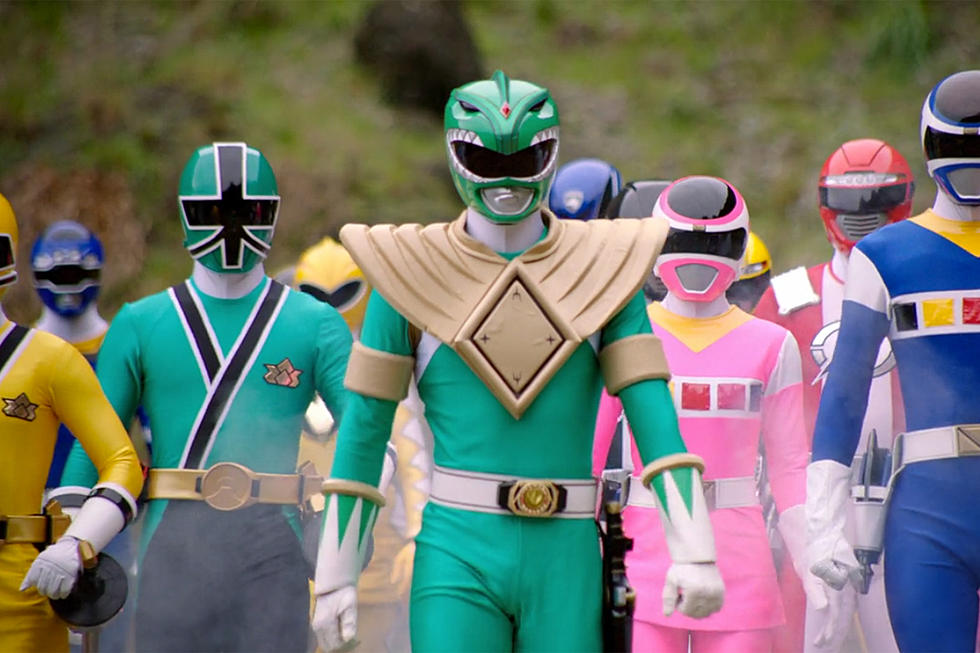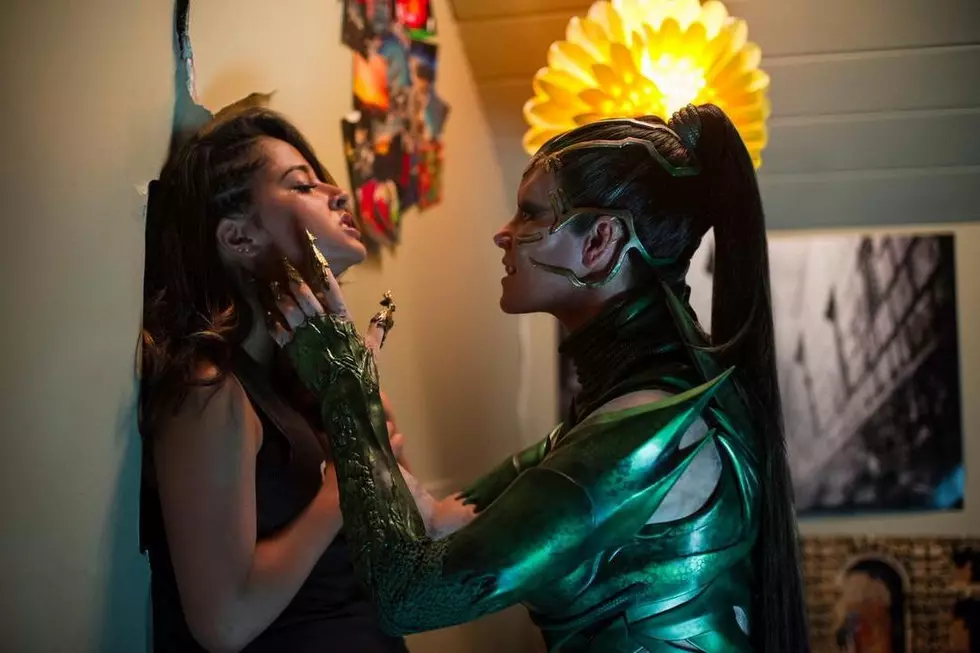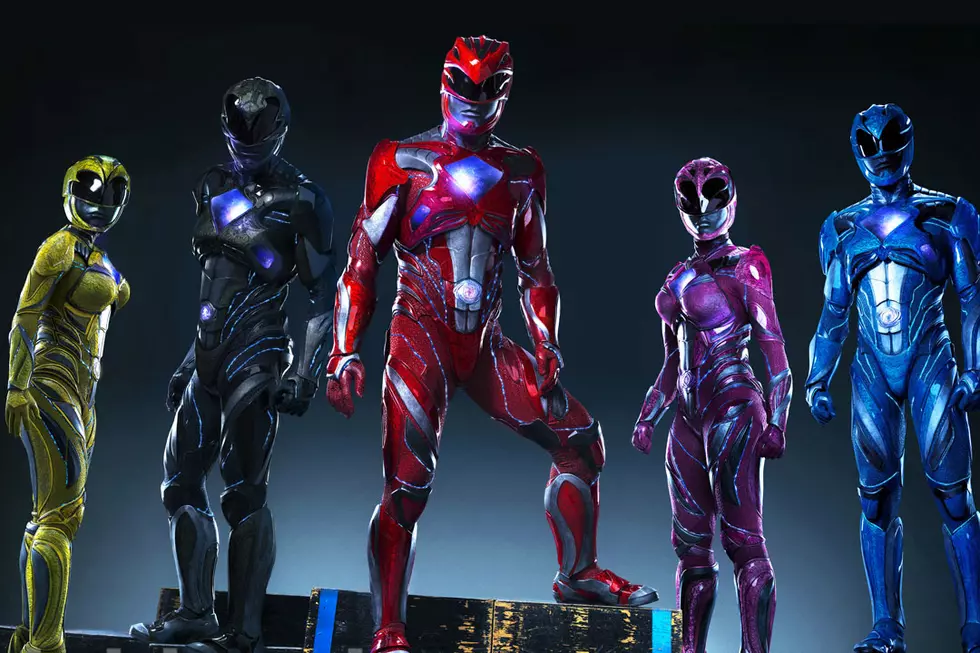
Ask Chris #162: Teenagers With Attitude
Q: As something that's seems so dated after 20 years, how does Power Rangers hold up as a superhero show? -- @prograpslady
A: In case you missed it, last Wednesday marked the 20th anniversary of Mighty Morphin Power Rangers. Well, in America, anyway -- Kyoru Sentai Zyuranger hit that mark last year in Japan, and it was the 16th season of Super Sentai when it started -- but still, it's a pretty big milestone. And between me and Caleb Goellner, who loves Power Rangers like the rest of you love oxygen, there was plenty of excitement here at ComicsAlliance when the big day rolled around.
As for how it holds up, well, I'll be the first to admit that a lot of it doesn't. At all. But even when that's the case, it's still absolutely fascinating.
Over the past few months, I've actually been watching the entire franchise from the beginning. It started when I watched the Christmas special for 2011's Power Rangers Samurai for an article and found it to be a lot better than I thought it was going to be. I ended up watching the entire series, and once I was through that, I decided to check back in and see if any of the other shows that missed out on because I am technically an adult were as good. The bad news is that they're not, but that's largely because Samurai is probably the best of the franchise.
Seriously, this thing is great. The Rangers are all teenagers from families that are destined to be samurai, and when they first meet each other, they stand asking each other who the Red Ranger is and then being surprised when someone says "No, I'm Pink!" or "I'm Green!" as though they are not wearing monochromatic outfits in their signature colors. Then the actual Red Ranger rolls up, in the middle of a city, riding a horse that he created by writing the Japanese symbol for "horse" with a magic cell phone. The bad guy is a wounded demon who wants to flood the river of the dead with the tears of human suffering and sends monsters through gateways to Hell that manifest as cracks in the sidewalk or shadowy alleys between buildings. One of the monsters has the ability to turn insults into explosions, and is only defeated because the Yellow Ranger is already suffering from depression and can't feel any worse about herself than she already does, and they end the first season with the Red Ranger cutting a dude in half with a sword and then kicking him off a cliff, where he also explodes.
What I'm getting at here is that Power Rangers Samurai is f**king awesome.
The other series -- at least from the 250 episodes I've managed to get through so far -- don't quite get to that level, but I'm still compelled to keep watching them. Even when the series is at its most crushingly unwatchable -- Turbo -- I'm thoroughly obsessed with how it's put together. When you get right down to it, it's a bizarre way of making television, cobbling together this weird Frankenstein's monster of a superhero story where half of it is pre-existing footage that's re-written and stapled to an entirely new bunch of footage starring completely different people, trying to make sense of things that were often originally created to be part of a completely different story. When you look at it that way, it's less about whether it holds up, and more just shocking that it ever worked at all.
And for the most part, it did, but not so well that you can't see the cracks in how it's assembled, and those are the parts that I find really interesting. There's a point in the first season, for instance, where the plots suddenly get a lot better. They're still weird as all hell, you understand, but everything seems to fall into place a little neater in a way that it hadn't before, in a way that feels slightly -- slightly -- more character driven than just built around a monster coming down to stomp on California until a robot made of dinosaurs shows up to do karate at it. The reason? Power Rangers was so successful that it managed to outlast its source material, and rather than just shifting to a straight adaptation of another series (which is the formula that they ended up with for the current shows), the American version started to rely more on original footage. Without having to write their way around so much content from Zyuranger, the stories felt a little more natural, even if they weren't always, you know, good.
But that's only part of why it's such a weird little chimaera of a television show. Up through Lost Galaxy in 1999, Power Rangers was essentially one long story with continuity going back to the first episode, built on a model that was more like American superheroes who just happened to get new robots and fight a new villain every year, rather than the original model of each season being its own separate story. But that said, with two exceptions -- and I'll get to those in a second -- there was very little that actually connected any of it, and a lot of that came down to the fact that the characters were essentially made to be interchangeable.
In a lot of ways, the American actors were standing in for their original Japanese counterparts in their full-body suits and helmets anyway, so even if you had a favorite -- Tommy -- the focus was always less on the characters and more on the action. There might've been enough there with Kimberly and Tommy's romance or the rivalry between the Red and Green Rangers to launch a generation of fan-fiction, but it was never the longing glances and unrequited romances of the X-Men or anything. As a result, it often mattered less who the Rangers were and more that there was just someone there to fill the role.
That might sound harsh, but seriously. There's a part where major characters leave the show and just aren't shown for several episodes until stand-ins get the news that they're being sent to Europe. Hell, there's this bit in Turbo where the entire cast is replaced in the span of two episodes, and the show just trundles along as though nothing happened.
Turbo is pretty terrible, you guys, but for that one shining moment, it was glam as f**k.
I think that's why In Space is considered to be such a high point. It goes in a completely different direction than its source material, and instead it's built like an American superhero comic. It uses continuity, establishes a defined goal that can progress alongside the monster-of-the-week format by having the Rangers hunt for a kidnapped Zordon -- is it still "kidnapping" if the victim is a floating translucent head in a giant glass tube? -- and uses original villains that allowed the people running the show to control the plot and move it in a direction that wasn't dictated by the source material.
That's not the only way to make it work, of course. The current shows like Samurai tend to follow their Japanese counterparts pretty closely, and it's actually gotten to the point where it's often a lot harder to tell where the Japanese footage ends and the American versions take over -- partly because they've come around to only casting tiny perfect angels in the roles so that everyone looks the same in costume. Still, watching that struggle between adapting the source material and diverging from it play out in the actual show is endlessly fascinating.
The weirdest thing about it, though, is how far it is from being a superhero story. I mean, it is a superhero show -- there's no getting around the fact that they have powers, dress up in costumes, and fight evil to protect the innocent -- but it's so different from what you see in comics. If I had to guess, I'd say that's because they're coming from a different place than the characters I'm most familiar with. American superheroes are all sort of descended from templates defined by Superman and Batman and then got shifted into a more modern characterization by Spider-Man. I'm not familiar enough with Japanese pop culture or even the original Super Sentai shows to make a guess as to where those stories have their roots (Kamen Rider? Astro Boy? It's got more in common with Supaida-Man than Supaida-Man does with Spider-Man), but they're definitely coming at it from a completely different place.
It's all right there in the first episode that aired 20 years ago, a story that's so bizarre that it opens with a moon witch emerging after ten thousand years from what is consistently referred to as "a dumpster."
Zordon lays out the basic rules for the series in that first episode, and by far, the weirdest one is the one about secret identities. Okay, well, no, the weirdest one is that they have to wait for the monster to turn gigantic and start smashing up buildings before they can go get their robots instead of just stomping on what they already know to be a murderous creature of pure evil with a metal T-Rex as soon as it shows up, but that's at least kind of easy to understand from a dramatic standpoint. The secret identies one, though, makes no sense.
It would be one thing if they were protecting their secret identities from Rita so that she wouldn't just sent Goldar down to knife them in their sleep -- something she curiously never does -- because that's pretty much the established reason to have a secret identity. Thing is, Rita knows who they are from day one and frequently sends monsters to fight them when they're just hanging out in the park. Instead, they're meant to keep their identities secret from everyone else. The only way to justify it even a little bit is if this is just a sub-section of the rule about not using their powers for personal gain by keeping them from becoming famous, but from a storytelling standpoint, it's the weirdest restriction to put on them. Whenever it comes up, everyone treats it really seriously and they always have to sneak off to transform, but it only actually matters, like, twice. Ever.
And then there's that thing where they never actually just go to the moon and shove Rita back in her dumpster, even though this seems to be completely within their powers. Arkham Asylum might have a revolving door, but at least there's a door there to revolve, you know?
Through all that, though, there are two things that holds up shockingly well throughout the history of the Power Rangers. And those two things... are Bulk and Skull.
Let that video play for the rest of the day. You'll thank me later.
Remember earlier, when I was talking about how the main cast was meant to be replaceable? Well, it turns out that the only characters who weren't were Farkas Bulkmeier and Eugene Skullovitch. Those dudes showed up in the first episode and stuck around longer than anyone, and they ended up being the only characters who had a real arc.
I know it's not surprising that the dude who prefers Jimmy Olsen to Superman thinks the real stars of Power Rangers were Bulk and Skull, but it's true. Go back and watch those first few episodes -- even though it's clear that they're the comic relief goofuses meant to be shown up by the clean-cut heroes, they're way more aggressive than you probably remember, especially to the girls. They're actually kind of weird and creepy for a little bit before they settle down in the role of bumbling troublemakers rather than, you know, actual criminals. But from there, in the background of everything else that's going on, they have this really interesting development where they're inspired by the Power Rangers to be better people, eventually wanting to become police officers and, failing that, getting to the point in Samurai where Bulk actually wants to teach Skull's son how to become a Samurai Ranger himself.
They're also the one window into how that world actually works for the people who don't have the ability to turn into superheroes: There's an episode where they have to take a psychological test to qualify as junior policemen ("Junior" in this case meaning "around 26 years old") where it's revealed that life under constant threat of annihilation by kaiju has made them pathologically obsessed with monsters -- and that in Angel Grove, this is actually considered completely normal, and even beneficial. It's a throwaway line, sure, but that s**t blew my mind when I saw it.
So yeah: those dudes hold up. And to be honest, every time I get depressed, I like to think about how they're best friends in real life, and that always cheers me up. And that is a lasting legacy to be proud of.
Ask Chris art by Erica Henderson. If you’ve got a question you’d like to see Chris tackle in a future column, just send it to @theisb on Twitter with the hashtag #AskChris.
More From ComicsAlliance









